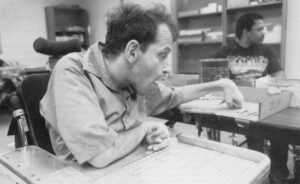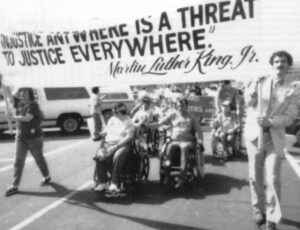Joseph Shapiro
- 1990

Fellowship Title:
- The Changing World of Disabled People
Fellowship Year:
- 1990

Re-Inventing the Wheel
The story of the disability rights movement could be written about Marilyn Hamilton’s impatience. It would start the summer day in 1978 when Hamilton crashed her hang glider nose down into the side of a California Sierra mountain. Her spinal cord was bruised and Hamilton became a paraplegic–a very impatient paraplegic. Hamilton zipped through rehabilitative therapy in three weeks. Most people take at least three months. Then she was impatient with the bulky wheelchair–”a stainless steel dinosaur,” she called it–that her physical therapist ordered for her. It was too heavy to get back out on the tennis court. So Hamilton sought out her friends and fellow glider pilots Don Helman and Jim Okamoto. Helman was driving a truck delivering parcels for UPS. Okamoto was managing a motorcycle shop. But the two, best friends since kindergarten, were also brilliant weekend inventors. They had begun designing hang gliders from a shed on the farm near Fresno owned by Helman’s parents. Build me an ultralight wheelchair, Hamilton asked them, out of the aluminum tubing you put in your

Pity is a Four-Letter Word
“One thing we’re going to vote on is a revolution!” Deep-felt cheers erupt from the convention crowd. “Resolution” is the word that T.J. Monroe wanted. But revolution, really, is more like it. Monroe and the 300 people in the hotel ballroom are retarded (a word they despise, but more on that in a moment). They are trailblazers of the self-advocacy movement, a new and spreading crusade of people with mental retardation to make their own decisions about everything from where they live to what they are called. “You have to do two things today,” Monroe exhorts his rapt followers to open the assembly. “You have to make thunder. You have to speak for your rights.” For his listeners, just gathering at this meeting is a daring and heady act of subversion. Others have always laid out their lives for them, telling them what to do and what to think. “You’re not gonna get in no trouble speaking for yourself, because there aren’t going to be laws in this room,” Monroe reassures the audience. “I want

Forcing the Young into Nursing Homes
Photos and text by Joseph P. Shapiro. Jeff Gunderson’s voice is choked with worry. He is about to reenter the place he calls “the concentration camp.” It is a nursing home, one of two where Gunderson, who has cerebral palsy, was sent from the time he was 18 until he turned 27. “I always said if I had to come back here, I’d rather be six feet under,” Gunderson says nervously as his attendant tugs him from the car parked outside the nursing home and lifts him into his wheelchair. Nine years have passed since he had lived here. He has returned to this brown-brick building of his nightmares because he wants to introduce a reporter to his former roommate, another man with cerebral palsy who, he says, is anxious to get out. Jeff Gunderson, with his attendant, Shaun Boyd, leave the Beloit, Wi. nursing home where Gunderson used to live. The trip was traumatic for both, as Boyd’s mother had multiple sclerosis and had lived in a nursing home from his birth to her

Climbing Society’s Mountains – The Disability Rights Movement Arrives
Back home in Austin, Texas, Bob Kafka and Randy Jennings usually fight each other. Yet both came to Washington the same week leading delegations of Texans to lobby for passage of a civil rights bill for disabled people. They shared the same goal, but their style and tactics could hardly have been more different. Kafka, a savvy protest veteran, brought 30 militant activists, all disabled and all members of American Disabled for Accessible Public Transit, or ADAPT. They came to disrupt Congress with protests, sit-ins and other acts of civil disobedience. Jennings and his 17 colleagues–only one of whom has a disability–are rehabilitation professionals who belong to the Texas chapter of the National Rehabilitation Association, or NRA. They had come for polite meetings with members of Congress to explain why their clients need their rights protected. At issue was the Americans with Disabilities Act, landmark legislation to extend to disabled Americans the types of guarantees against discrimination in public accommodation and employment that were granted blacks, women and ethnic minorities in the Civil Rights Act
